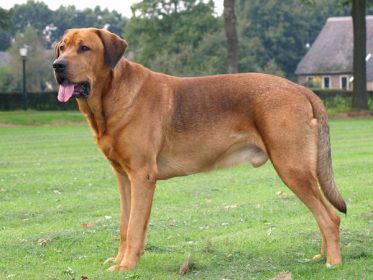
If you look at this dog too quickly, you may think you’ve seen a Mastiff, but a more studied examination dispels any notion that you know what the breed is at all unless you are already familiar with the Broholmer. Time to brush up. The Broholmer has been an AKC FSS breed since 2013.
The breed, however, has been around much longer. As in “Middle Ages” longer. Called the “slagterhunden” (Butcher’s dog) in Denmark, its country of origin, the Broholmer was the result of crossing a German Mastiff (though some say it was Danish) – a gift from German royalty – with an English Mastiff, a gift from English royalty. The dogs soon became royal favorites. Christian IV kept Broholmers, and Countess Danner and King Frederik VII owned several. One of them, “Tyrk,” was a particular favorite and was even included in a portrait of the couple painted in 1859. The Copenhagen Zoological Museum now has “Tryk’s” stuffed remains on display.
When the breed gains full AKC recognition, it will be in the Working Group, but in the middle centuries, it was used for stag hunting. Later on, it became a guard dog for estates, manors, and large farms. By the end of the 18th century, Broholmers increased in numbers thanks to the man from whom they got their current name: Count Neils Frederik Sehested of Broholm-Funen. We love this next part: To help bolster breed numbers, Count Sehested gave puppies away to Danish people on the condition that they continue breeding. To honor his efforts, the breed was named Broholmer after his estate.
Distemper and WWII decimated the breed, but in the mid 197os, The Society for Reconstruction of the Broholmer Breed, with the support of the Danish Kennel Club, began the work of reviving the breed. Incredibly, a cynologist, Jytte Weiss, found two quality Broholmers that matched the old 1886 standard. Encouraged by the find, veterinarians, dog lovers and fanciers scoured the country for more, and found them in villages where farmers, ranchers, woodmen and every day folk had kept the breed alive.
In January, 1988, selling a Broholmer outside of Denmark became allowed, but only with the stipulation that only 10% of the puppies born could be sold and exported.
Broholmer photo by Thrudgelmir – Own work, under Public Domain, https://commons.wikimedia.org/w/index.php?curid=8015473
